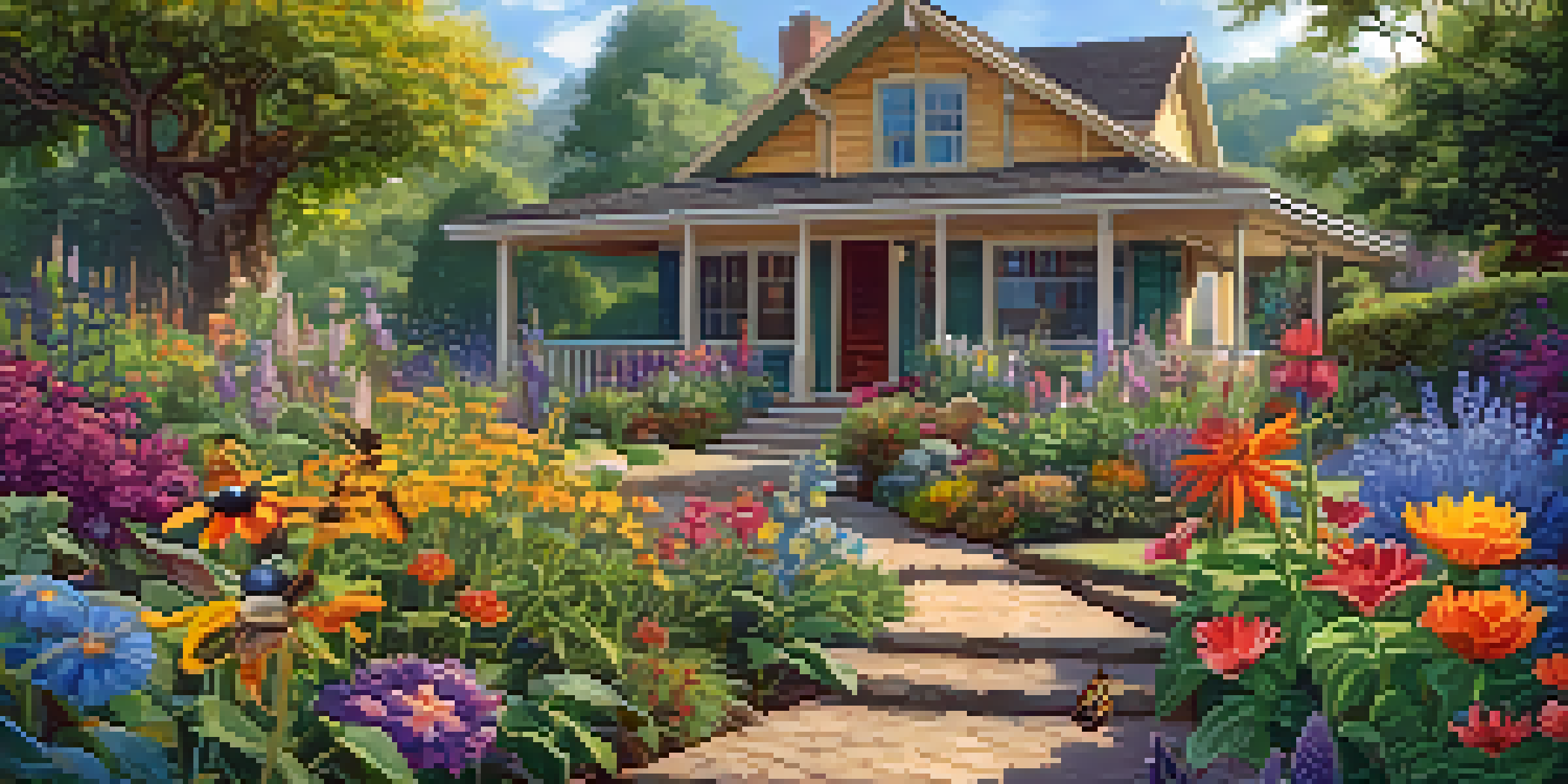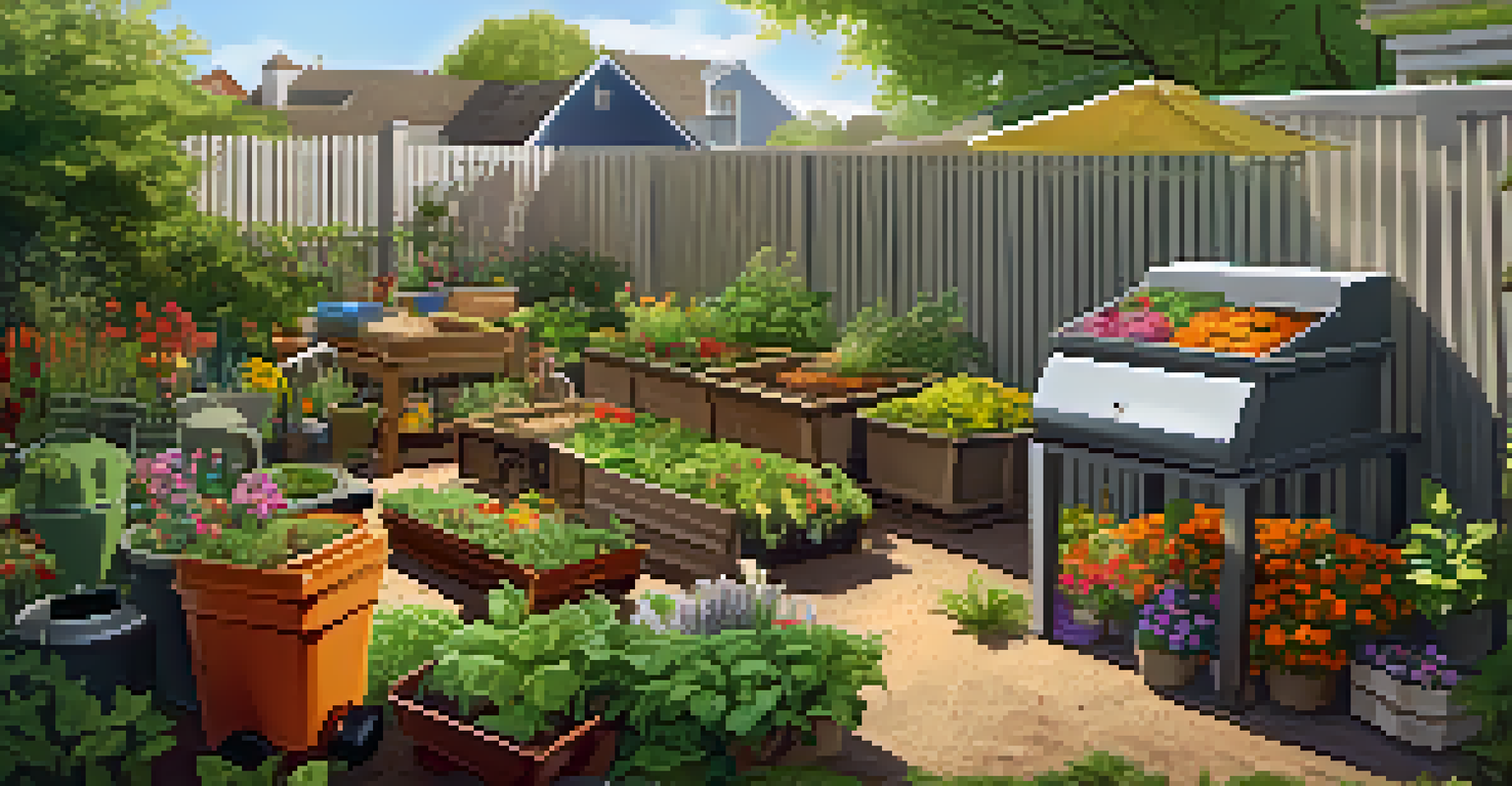Sustainable Landscaping Ideas for Eco-Friendly Homes

Choosing Native Plants for Sustainable Landscaping
One of the best ways to create a sustainable landscape is by choosing native plants. These plants are naturally adapted to the local climate and soil, meaning they require less water and maintenance. For example, if you live in a dry area, opting for drought-resistant native plants can help conserve water while providing a vibrant garden.
The greatest threat to our planet is the belief that someone else will save it.
Native plants also attract local wildlife, including pollinators like bees and butterflies, which are crucial for maintaining ecological balance. By planting these species, you contribute to the health of your local ecosystem. Additionally, they can thrive without chemical fertilizers or pesticides, making your garden even more eco-friendly.
Incorporating native plants into your garden design not only supports the environment but also creates a unique and beautiful landscape that reflects the natural beauty of your region. So, before you head to the nursery, do some research on which native plants will flourish in your garden.
Implementing Rain Gardens for Water Management
Rain gardens are a fantastic way to manage stormwater while enhancing your landscape's beauty. These gardens are designed to capture and absorb rainwater runoff from roofs, driveways, and parking lots, reducing the risk of flooding and erosion. You can create a rain garden by digging a shallow depression and filling it with native plants that thrive in wet conditions.

Not only do rain gardens help manage water effectively, but they also filter pollutants before they reach local waterways. This means that you're not just adding aesthetic value to your home; you're actively protecting the environment. Plus, they can be a stunning focal point in your yard, providing a habitat for various wildlife.
Choose Native Plants for Sustainability
Selecting native plants reduces water usage and maintenance while supporting local wildlife.
By taking advantage of natural rainfall, rain gardens can significantly reduce the need for additional irrigation, saving both water and money. It's a simple yet impactful way to make your landscaping more sustainable.
Creating a Compost Area for Nutrient-Rich Soil
Creating a compost area in your backyard is an excellent way to recycle kitchen scraps and yard waste into nutrient-rich soil. Composting not only reduces waste but also enriches your garden soil, allowing plants to thrive without the need for chemical fertilizers. You can start small by using a compost bin or simply creating a designated pile in a corner of your yard.
In every walk with nature one receives far more than he seeks.
As the organic materials break down, they produce a dark, crumbly substance known as compost, which is a fantastic amendment for your garden. This natural fertilizer improves soil structure, moisture retention, and nutrient availability, leading to healthier plants. Plus, it’s a great way to involve the whole family in eco-friendly practices.
By implementing composting, you’re closing the loop in your garden’s ecosystem, ensuring that nothing goes to waste. It’s a simple action that can have a profound impact on the sustainability of your landscaping.
Incorporating Permeable Paving for Sustainable Hardscaping
When it comes to hardscaping, choosing permeable paving materials can greatly enhance your landscape's sustainability. Unlike traditional concrete, permeable pavers allow rainwater to seep through, reducing runoff and promoting groundwater recharge. This helps to prevent flooding and ensures that the water is naturally filtered before it returns to the soil.
Using permeable materials like gravel, porous concrete, or permeable asphalt not only supports environmental health but can also add an appealing aesthetic to your outdoor spaces. They come in various designs and colors, allowing for creative and attractive pathways, driveways, or patios. You can even incorporate them alongside native plants for a cohesive look.
Implementing Rain Gardens
Rain gardens capture stormwater, reduce flooding, and filter pollutants, enhancing both beauty and sustainability.
By opting for permeable paving, you're making a conscious choice to minimize your impact on local waterways while creating functional and beautiful outdoor areas. It’s a win-win for your landscape and the environment.
Utilizing Mulch for Soil Moisture and Weed Control
Mulching is a simple yet effective practice for sustainable landscaping that offers multiple benefits. By applying a layer of organic mulch, such as wood chips or straw, around your plants, you can help retain soil moisture, reduce the need for frequent watering, and suppress weed growth. This means less time spent on maintenance and more time enjoying your garden.
Additionally, as organic mulch breaks down, it enriches the soil with nutrients, promoting healthier plant growth. This natural process helps create a thriving ecosystem in your garden, supporting beneficial insects and microorganisms. It’s like giving your plants a cozy blanket that keeps them comfortable and nourished.
Incorporating mulch into your landscaping not only enhances its sustainability but also improves its overall appearance. With various colors and textures available, you can choose mulch that complements your garden's design.
Designing an Edible Landscape for Food Sustainability
Designing an edible landscape is a fantastic way to combine aesthetics with sustainability. By incorporating fruit trees, vegetable gardens, and herb beds into your landscaping, you create a beautiful and functional space. This not only provides fresh produce right at your doorstep but also reduces the carbon footprint associated with transporting food from grocery stores.
Imagine stepping outside to pick fresh tomatoes for your salad or herbs for your cooking, all while enjoying the beauty of your garden. An edible landscape can be just as visually appealing as a traditional ornamental garden, with colorful fruits, vibrant vegetables, and fragrant herbs adding life to your outdoor space.
Create Edible Landscapes
Designing edible landscapes combines aesthetics with food production, promoting sustainability and personal health.
By growing your own food, you can also make a positive impact on your health and well-being. Plus, it’s a rewarding experience that connects you with nature and fosters a deeper appreciation for the environment.
Incorporating Wildlife Habitats into Your Landscape
Creating wildlife habitats within your landscape is an excellent way to promote biodiversity and support local ecosystems. Simple additions like birdhouses, bee hotels, and butterfly gardens can attract various species, enriching your outdoor experience. This not only helps the environment but also creates a lively and dynamic space that you can enjoy year-round.
By providing food, water, and shelter for wildlife, you're encouraging natural pest control and pollination, which is beneficial for your garden's health. For instance, attracting birds can help keep pest populations in check, reducing the need for pesticides. Additionally, seeing butterflies and bees thrive in your garden is a delightful reminder of nature's beauty.

Incorporating wildlife-friendly features into your landscaping fosters a connection between your home and the natural world. It's a simple step that can lead to a more vibrant and sustainable ecosystem right in your backyard.
Maintaining Your Eco-Friendly Landscape Sustainably
Maintaining your eco-friendly landscape is key to ensuring its sustainability over time. This includes using organic gardening practices, such as natural pest control and composting, to keep your garden healthy without harmful chemicals. Regularly assessing your garden's needs and adjusting your care routine can make a significant difference in its overall health.
Consider implementing a rainwater collection system to further enhance your landscape's sustainability. By capturing rainwater in barrels, you can provide your plants with a free and natural source of irrigation. This not only conserves water but also helps reduce your utility bills.
Ultimately, maintaining an eco-friendly landscape is about being mindful and proactive. With a little effort, you can create a thriving outdoor space that benefits both your home and the environment for years to come.